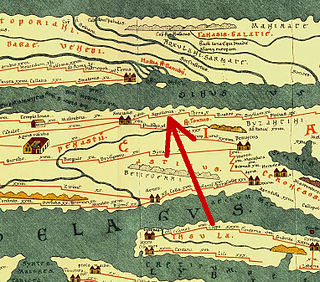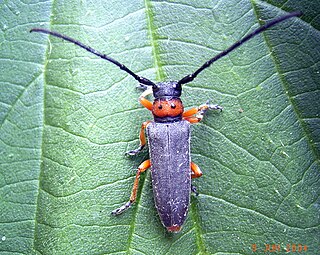
Heraclea Pontica, known in Byzantine and later times as Pontoheraclea, was an ancient city on the coast of Bithynia in Asia Minor, at the mouth of the river Lycus. It was founded by the Greek city-state of Megara in approximately 560–558 BC and was named after Heracles who the Greeks believed entered the underworld at a cave on the adjoining Archerusian cape. The site is now the location of the modern city Karadeniz Ereğli, in the Zonguldak Province of Turkey.

Prusias I Cholus was a king of Bithynia, who reigned from c. 228 to 182 BC.
Comana Pontica, was an ancient city located in ancient Pontus, on the river Iris, at modern Gümenek near Tokat in Turkey.

Ladik is a municipality and district of Samsun Province, Turkey. Its area is 541 km2, and its population is 16,072 (2022). It is on the site of the ancient Laodicea Pontica. The mayor is Adnan Topal (AKP).

Via Pontica was an ancient Roman road in Thrace along the Black Sea, starting from Byzantium and passing through Deultum, Aquae Calidae, Apollonia, Mesembria, Odessos, Byzone, and Kaliakra ; and then through Kallatis, Tomis, and Istros.

Phytoecia is a genus of longhorn beetles of the subfamily Lamiinae,
Phytoecia gianassoi is a species of beetle in the family Cerambycidae. It was described by Sama in 2007 and later reclassified to the subgenus Coptosia within the genus Phytoecia.
Phytoecia paulusi is a species of beetle in the family Cerambycidae. It was described by Holzschuh in 1971.

Phytoecia puncticollis is a species of beetle in the family Cerambycidae. It was described by Faldermann in 1837. It is known from Russia, Azerbaijan, Georgia, Iraq, Armenia, Turkey, Iran, and Turkmenistan. It feeds on Eryngium billardierei.
Phytoecia gaubilii is a species of beetle in the family Cerambycidae. It was described by Mulsant in 1851. It is known from Tunisia and Algeria.

Phytoecia comes is a species of beetle in the family Cerambycidae. It was described by Henry Walter Bates in 1884. It is known from Taiwan, Myanmar, North Korea, South Korea, China, Vietnam, and Japan.
Phytoecia humeralis is a species of beetle in the family Cerambycidae. It was described by Waltl in 1838, originally under the genus Saperda. It is known from Palestine, Greece, Georgia, Iran, Azerbaijan, Syria, Cyprus, and Turkey. It feeds on Silybum marianum.
Phytoecia millefolii is a species of beetle in the family Cerambycidae. It was described by Adams in 1817, originally under the genus Saperda. It has a wide distribution between Europe and the Middle East.

Phytoecia affinis is a species of beetle in the family Cerambycidae. It was described by Harrer in 1784, originally under the genus Leptura. It has a wide distribution in Europe.

Phytoecia caerulescens is a species of beetle in the family Cerambycidae. It was described by Scopoli in 1763, originally under the genus Leptura. It has a wide distribution in Europe, and has been introduced into Australia. It feeds on Echium vulgare, Lappula squarrosa, Anchusa officinalis, Lithospermum officinale, and Cynoglossum officinale.

Phytoecia caerulea is a species of beetle in the family Cerambycidae. It was described by Scopoli in 1772, originally under the genus Leptura. It has a wide distribution in Europe.

Phytoecia icterica is a species of beetle in the family Cerambycidae. It was described by Schaller in 1783, originally under the genus Saperda. It has a wide distribution between Europe and the Middle East. It feeds on Daucus carota sativus, Petroselinum crispum, Pastinaca sativa sativa, Pastinaca sativa, Conium maculatum, and Pimpinella saxifraga.

Phytoecia rufiventris is a species of beetle in the family Cerambycidae. It was described by Gautier des Cottes in 1870. It is known from Russia, Japan, Taiwan, Mongolia, North Korea, South Korea, China, and Vietnam. It feeds on Artemisia vulgaris.
Phytoecia tenuilinea is a species of beetle in the family Cerambycidae. It was described by Léon Fairmaire in 1877. It is known from Morocco and Algeria.
Phytoecia hirsutula is a species of beetle in the family Cerambycidae. It was described by Frölich in 1793, originally under the genus Saperda. It has a wide distribution between Europe and the Middle East.











